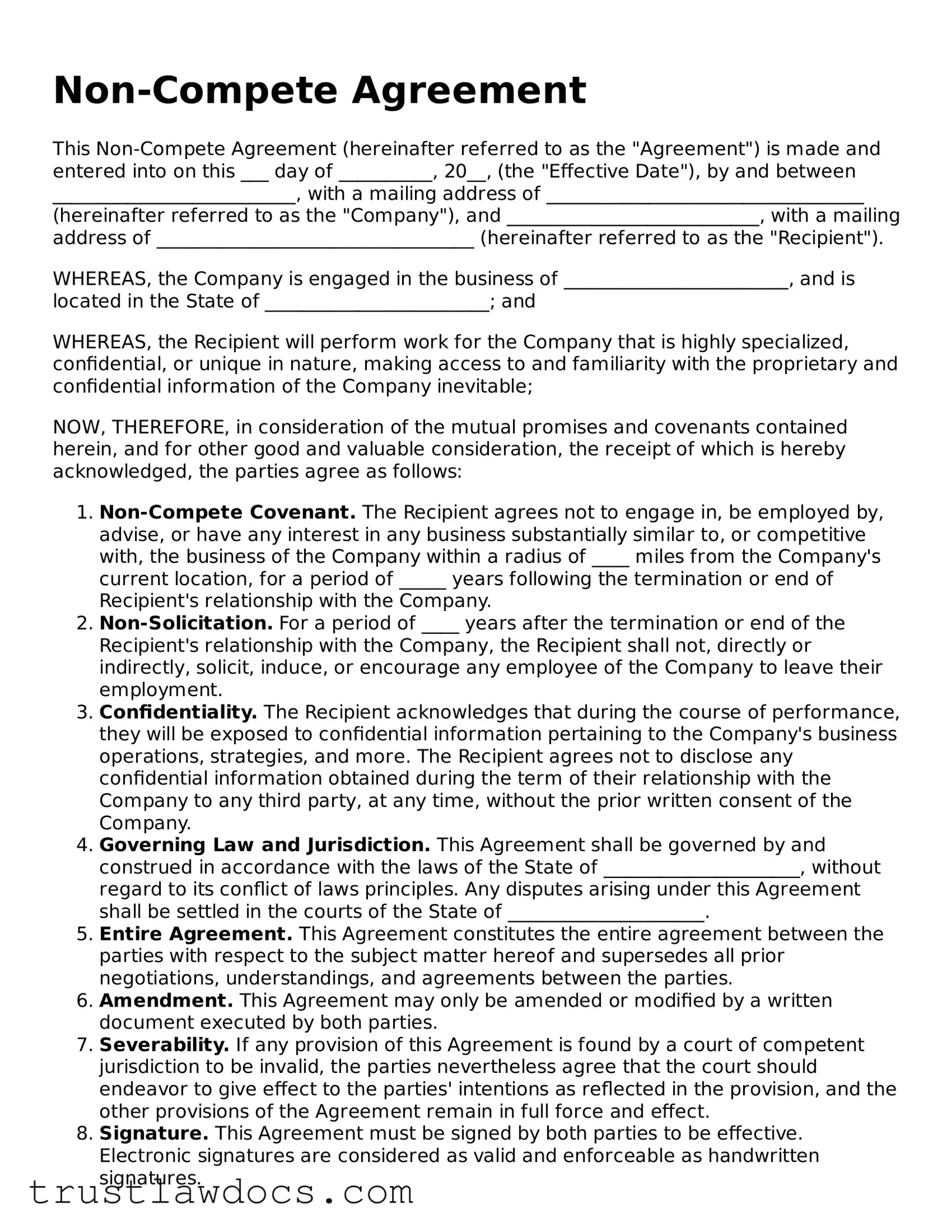Non-Compete Agreement
This Non-Compete Agreement (hereinafter referred to as the "Agreement") is made and entered into on this ___ day of __________, 20__, (the "Effective Date"), by and between __________________________, with a mailing address of __________________________________ (hereinafter referred to as the "Company"), and ___________________________, with a mailing address of __________________________________ (hereinafter referred to as the "Recipient").
WHEREAS, the Company is engaged in the business of ________________________, and is located in the State of ________________________; and
WHEREAS, the Recipient will perform work for the Company that is highly specialized, confidential, or unique in nature, making access to and familiarity with the proprietary and confidential information of the Company inevitable;
NOW, THEREFORE, in consideration of the mutual promises and covenants contained herein, and for other good and valuable consideration, the receipt of which is hereby acknowledged, the parties agree as follows:
- Non-Compete Covenant. The Recipient agrees not to engage in, be employed by, advise, or have any interest in any business substantially similar to, or competitive with, the business of the Company within a radius of ____ miles from the Company's current location, for a period of _____ years following the termination or end of Recipient's relationship with the Company.
- Non-Solicitation. For a period of ____ years after the termination or end of the Recipient's relationship with the Company, the Recipient shall not, directly or indirectly, solicit, induce, or encourage any employee of the Company to leave their employment.
- Confidentiality. The Recipient acknowledges that during the course of performance, they will be exposed to confidential information pertaining to the Company's business operations, strategies, and more. The Recipient agrees not to disclose any confidential information obtained during the term of their relationship with the Company to any third party, at any time, without the prior written consent of the Company.
- Governing Law and Jurisdiction. This Agreement shall be governed by and construed in accordance with the laws of the State of _____________________, without regard to its conflict of laws principles. Any disputes arising under this Agreement shall be settled in the courts of the State of _____________________.
- Entire Agreement. This Agreement constitutes the entire agreement between the parties with respect to the subject matter hereof and supersedes all prior negotiations, understandings, and agreements between the parties.
- Amendment. This Agreement may only be amended or modified by a written document executed by both parties.
- Severability. If any provision of this Agreement is found by a court of competent jurisdiction to be invalid, the parties nevertheless agree that the court should endeavor to give effect to the parties' intentions as reflected in the provision, and the other provisions of the Agreement remain in full force and effect.
- Signature. This Agreement must be signed by both parties to be effective. Electronic signatures are considered as valid and enforceable as handwritten signatures.
IN WITNESS WHEREOF, the parties have executed this Non-Compete Agreement as of the Effective Date first above written.
COMPANY: ___________________________________
By: __________________________________________
Title: ________________________________________
Date: _________________________________________
RECIPIENT: __________________________________
Date: _________________________________________
